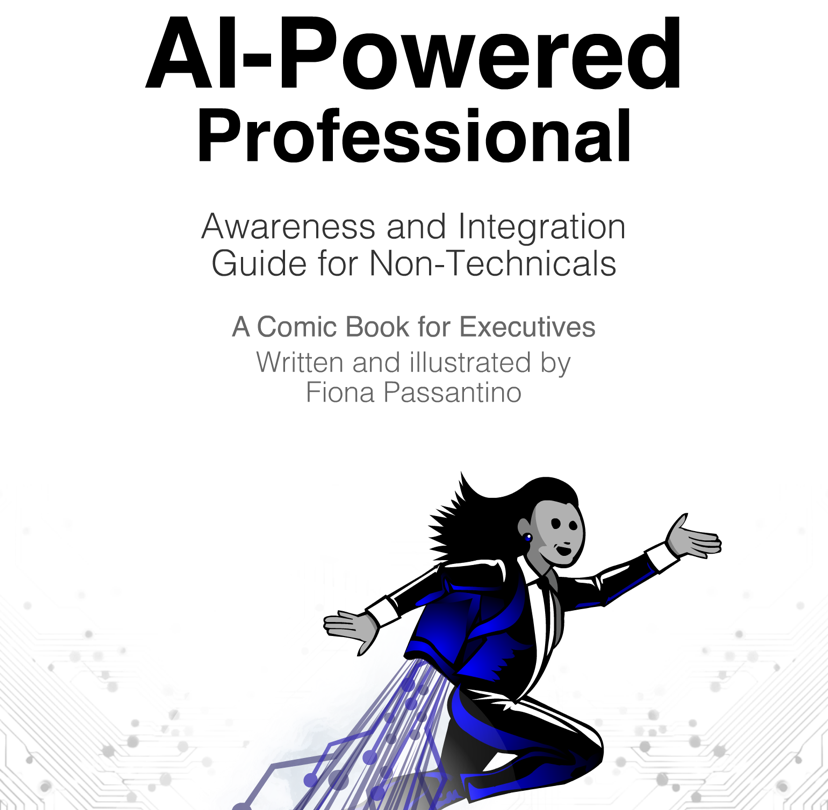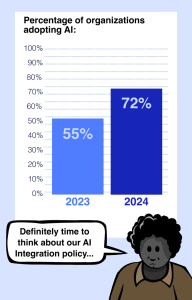Are you ready for change? Six steps to employee-driven AI integration
Written by Fiona Passantino Tuesday 11 February 2025
Post-Covid office workers find themselves overwhelmed with the daily chatter of working life.
Our sustained, daily exposure to a near-constant stream of incoming emails, messages, web chats, social streams, webinars and meetings, combined with the expectation to respond and react to all of them instantly, seems to grow by the day. In 2024, 82% of employees were considered at risk of burnout, a sharp increase from our pre-pandemic days, but only 50% of organisations make workflow adjustments to support mental health.
Employees are using AI with or without their managers’ knowledge or consent; to get things done, clear their plates and meet rising expectations. Microsoft and LinkedIn found that up to 75% of people in desk jobs are using AI at work in 2024, double the amount in 2023.
Unlike other technology revolutions in the past that impacted productivity – such as ecommerce, smartphone integration or digitalisation – workplace adoption of AI is mostly bottom-up, inspired by the people doing the work. As many as 78% of us bring our own AI tools to the office, quietly or otherwise, and use them for repetitive tasks, ideation or data processing.
The way forward? Employee-driven change

Yet, fewer than 40% of us using AI at work have received training in it; employees are largely upskilling themselves and providing their own governance. AI integration can be seen more positively by employees than leaders, even though the addition of AI to the workflow might mean higher workloads and decreased job security as fewer humans become positioned to do the same work. Leaders may be less excited by systemic AI adoption, even though it means greater productivity, higher-quality results, increased employee engagement and better customer service.
You may feel that something needs to change within your organisation. Perhaps existing AI policy is too strict, too lax or non-existent. Or maybe your training needs are not supported, and there doesn’t seem to be a master plan to adopt AI in a structured way.
Here’s how to instigate bottom-up change, create a movement and push for a new strategic plan…
1. First, know your culture
Let’s face it; some organisations foster a culture of innovation and renewal, and some are stuck in the past. Take a moment to consider the place where you work; is bottom-up change of this kind possible, has it successfully been done before – an agile transformation, for instance, digitisation or mobile-first design?
Four ways to self-diagnose your organisation’s workplace culture
- Assess core values and beliefs: Mission statements and open policies generally list a set of globally accepted values, meant to inspire and connect a working community. But, as with people, values are not reflected in the statements on the wall, but are seen in daily operations and decision-making.
- Evaluate leadership and decision making: Analyse how leaders communicate expectations and make decisions from the C-suite straight to team lead.
- Examine employee experience: Find out whether you can see the data gathered through the standard annual surveys or focus groups or try and gather your own by speaking to others within the organisation about the state of employee happiness.
- Analyse communication patterns: The transparency of internal communications and the effectiveness of formal and informal channels in facilitating open dialogue is a marker of organisational trust.
2. Begin an education campaign
The best way to instigate change is by educating those around you. If you can, give a few short webinars about AI – what it is, how it works, how you use it and what the risks and benefits are – to anyone in the organisation who will listen.
If you have access to a budget, bring in external experts to give AI keynotes, training or workshops. Curate a short masterclass series of free webinars about AI and share this with internal comms or HR development. This could involve specific sessions tailored to different departments.
When employees understand AI and its applications, they are more likely to identify areas where it can be beneficial in their own daily work and to join your push for change.
Get clued up on AI with CMI’s expert webinars…
Want to discover the next four steps on Fiona’s path to successful employee-driven AI integration?
Register for Free Access
Not yet a Member, Subscriber or Friend? Register as a CMI Friend for free, and get access to this and many other exclusive resources, as well as weekly updates straight to your inbox.
You have successfully registered
As a CMI Friend, you now have access to whole range of CMI Friendship benefits.
Please login to the left to confirm your registration and access the article.
Article
Our extensive range of articles are designed to keep you in the loop with all the latest management and leadership best practice, research and news.
Members See More
CMI Members have access to thousands of online learning and CPD resources. Learn more about our membership benefits
Join The Community
CMI offers a variety of flexible membership solutions, tailored to your needs. Find out more and get involved in the CMI community today.
